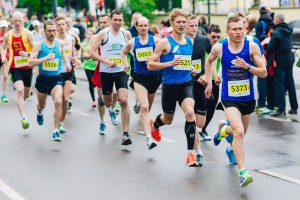You can always tell when Great North Run season is in full swing: the number of runners you see out and about in the North East increases massively!

There are only three months to go until the big day, and, despite the unseasonably damp and cold weather, our streets are now full of runners well into their Great North Run training.
It’s always fascinating for us, as sports injury professionals, to see the wide range of running styles as people run past. The way we run is a deeply personal thing – as a rule, you could see ten different runners, and see ten different running styles. Sadly, this individualism can be problematic, too.
People tend to run in the way they feel most comfortable, and stick with it. A lot of people never have their gait corrected, because it’s possible to reach a very good level of performance and still have quite a poor running style.
Sadly, we can’t all run with a gait like Haile Gebrselassie:
The bad news is that, in many cases, a runner’s gait can have a negative impact on their body. A flawed biomechanical function can cause pain and injuries, and the longer a runner spends running, the more damage could potentially be caused.
The good news is that running style and running technique can be adjusted through a detailed analysis and an emphasis on connecting poor movement patterns.
The brilliant thing about the Great North Run is that it inspires people of all shapes, sizes and fitness levels to take on the challenge. Whether you are an elite runner or a complete novice, the Great North Run represents a huge challenge and should be taken very seriously.
That includes ensuring you are not causing any damage to your body as a result of incorrect running technique.
At Newcastle Sports Injury Clinic, we operate a running clinic, aimed at helping prevent injury and maximising performance. We deal with people who are new to running, right through to people who are looking to shave vital seconds (or even less) off their personal best times.

The great thing about our work with running retraining is that pain relief can be instant. By adjusting the way people run can eliminate chronic pains people have experienced with running. This gives the therapist an insight into weakness and imbalance.
Our running clinic brings together our in-house Physiotherapy and Podiatry specialists, who can give expert treatment and advice. The Podiatrist is able to identify whether a patient’s injury is caused by poor structural alignment or by function, by assessing a patient’s biomechanical structure, using a range of techniques, including computerised gait analysis.
The testing we carry out during a running clinic is incredibly detailed and scientific. It enables us to provide a full report to the patient about their running style specific advice on improvements that can be made.
In many cases, we believe that we can not only treat and prevent injuries (though those are huge incentives to come to see us!) but also help to improve performance.

